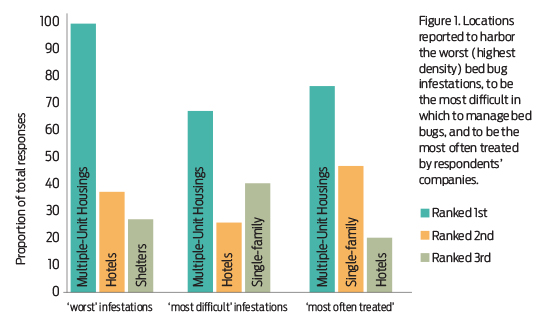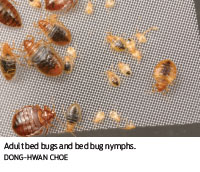Bed bugs and roommates
.jpg/1024px-Roommates_(3218131407).jpg)
Bed bug management is especially challenging in public and subsidized housing environments, apartments, and other low-income, multi-unit housing (MUH) situations. In these environments, high rates of resident turnover, lack of economic and educational resources, ease of bed bug dispersal between units, and communication barriers such as literacy and language limitations may all contribute to chronic infestations. Researchers and policymakers recognize the need to address this challenging situation and to design valuable and timely extension and applied research programs in order to assist pest management professionals (PMPs) engaged in this work. Data on bed bug incidence and management approaches in the western United States are lacking as compared to those on the Eastern Seaboard and in the Midwest. To this end, several western urban entomologists and extension specialists have recently formed a work group with funding provided by the USDA’s Western Integrated Pest Management Center (WIPMC). The first task of the WIPMC Bed Bug Work Group was to assess the current prevailing bed bug management practices in use, the most challenging aspects associated with bed bug management in MUHs, and the self-reported needs of the industry that may improve bed bug management outcomes in these environments. An online survey was developed and distributed nationally (pctonline.com), regionally (via Work Group members’ websites and personal networks), and in California (Target Specialty Products client lists) to capture these desired data. A total of 114 individual PMPs completed this survey, with over 76% of these responses coming from the targeted western region (AK, AZ, CA, CO, HI, ID, MT, NV, NM, OR, UT, WA, WY), mostly from California (60% of total responses). Data presented are from all 114 respondents. Most (64%) PMPs represented small businesses (less than 20 total employees), but some (15%) hailed from large pest control companies (100 or more total employees). Though considered a very experienced group of pest management professionals (average experience in pest control industry was 22.7 years), most had only started managing bed bugs during the past 10 years (mean duration of bed bug experience = 9.6 years), thus reflecting the recent resurgence of bed bugs as key urban pests in the United States. The number of PMPs responding to the survey was low compared to the total number of licensed individuals within the region. Therefore, we caution PCT’s readers to consider that our results and findings may differ from other and future surveys on PMP attitudes, behaviors, and practices involving bed bug detection and management. A summary of responses to the survey is as follows:
PMPs’ Attitudes, Beliefs, Observations.
Most respondents (73%) believed that bed bug infestations had increased in 2014 as compared to 2013 while some (22%) believed that the levels of infestation had not changed during this period. This trend was stable when considering responses from different regions and states, suggesting that bed bug incidence may be increasing throughout the nation. Virtually half (49%) of all respondents considered summer to be the season with the most calls for bed bug services, while another large proportion (44%) reported no differences between seasons. It is unclear whether summer incidence may be driven by increased human travel, increased ambient temperature, or some combination of these and perhaps unknown factors. Though resistance to insecticides within bed bug populations has been a concern for some time now, the majority (57%) of respondents in this survey did not believe they had encountered resistance in the field. This was true even when considering data only from the Midwest and the Eastern Seaboard, where resistance in field populations has been reported as widespread. Furthermore, though insecticide resistance may be more easily recognized by those with the most years working in the field, the level of experience of respondents had no effect on this reported belief. MUHs, the focus of this survey, were considered by most respondents to harbor the worst (highest density) bed bug infestations, to be the most difficult locations in which to manage bed bugs, and to be the locations most often treated by their companies (96%, 65%, 74%, respectively) (Figure 1, above). Hotels/motels and shelters were also believed to harbor high-density infestations.
Read more at: http://bit.ly/1MAtjTf


 Most respondents (73%) believed that bed bug infestations had increased in 2014 as compared to 2013 while some (22%) believed that the levels of infestation had not changed during this period. This trend was stable when considering responses from different regions and states, suggesting that bed bug incidence may be increasing throughout the nation. Virtually half (49%) of all respondents considered summer to be the season with the most calls for bed bug services, while another large proportion (44%) reported no differences between seasons. It is unclear whether summer incidence may be driven by increased human travel, increased ambient temperature, or some combination of these and perhaps unknown factors. Though resistance to insecticides within bed bug populations has been a concern for some time now, the majority (57%) of respondents in this survey did not believe they had encountered resistance in the field. This was true even when considering data only from the Midwest and the Eastern Seaboard, where resistance in field populations has been reported as widespread. Furthermore, though insecticide resistance may be more easily recognized by those with the most years working in the field, the level of experience of respondents had no effect on this reported belief. MUHs, the focus of this survey, were considered by most respondents to harbor the worst (highest density) bed bug infestations, to be the most difficult locations in which to manage bed bugs, and to be the locations most often treated by their companies (96%, 65%, 74%, respectively) (Figure 1, above). Hotels/motels and shelters were also believed to harbor high-density infestations.
Most respondents (73%) believed that bed bug infestations had increased in 2014 as compared to 2013 while some (22%) believed that the levels of infestation had not changed during this period. This trend was stable when considering responses from different regions and states, suggesting that bed bug incidence may be increasing throughout the nation. Virtually half (49%) of all respondents considered summer to be the season with the most calls for bed bug services, while another large proportion (44%) reported no differences between seasons. It is unclear whether summer incidence may be driven by increased human travel, increased ambient temperature, or some combination of these and perhaps unknown factors. Though resistance to insecticides within bed bug populations has been a concern for some time now, the majority (57%) of respondents in this survey did not believe they had encountered resistance in the field. This was true even when considering data only from the Midwest and the Eastern Seaboard, where resistance in field populations has been reported as widespread. Furthermore, though insecticide resistance may be more easily recognized by those with the most years working in the field, the level of experience of respondents had no effect on this reported belief. MUHs, the focus of this survey, were considered by most respondents to harbor the worst (highest density) bed bug infestations, to be the most difficult locations in which to manage bed bugs, and to be the locations most often treated by their companies (96%, 65%, 74%, respectively) (Figure 1, above). Hotels/motels and shelters were also believed to harbor high-density infestations.